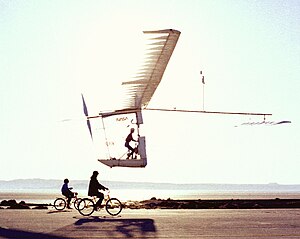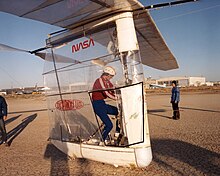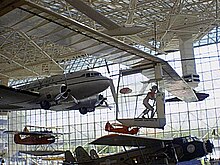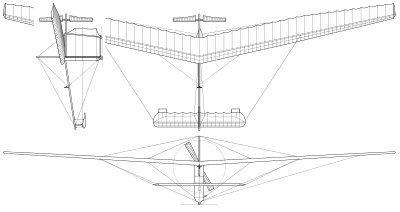MacCready Gossamer Albatross
| Gossamer Albatross | |
|---|---|

| |
| The Gossamer Albatross II at Dryden Flight Research Center in 1980 | |
| Role | experimental aircraft |
| National origin | United States |
| Manufacturer | AeroVironment |
| Designer | Paul MacCready |
| First flight | 1979 |
| Status | museum piece (both) |
| Number built | 2 |
| Developed from | Gossamer Condor |
| Developed into | Gossamer Penguin |
The Gossamer Albatross is a human-powered aircraft built by American aeronautical engineer Dr. Paul B. MacCready's company AeroVironment. On June 12, 1979 it completed a successful crossing of the English Channel to win the second Kremer prize.
Design and development
The aircraft was designed and built by a team led by Paul B. MacCready, a noted US aeronautics engineer, designer, and world soaring champion. Gossamer Albatross was his second human-powered aircraft, the first being the Gossamer Condor, which had won the first Kremer prize on August 23, 1977 by completing a mile-long figure-eight course. The second Kremer challenge was then announced as a flight across the Channel recalling Louis Blériot's crossing of 1909.
The Albatross was powered using pedals to drive a large two-bladed propeller. On June 12 1979, piloted by amateur cyclist Bryan Allen, it completed the 35.8 km (22.2 mi) crossing in 2 hours and 49 minutes, achieving a top speed of 29 km/h (18 mph) and an average altitude of 1.5 metres (5 ft).

The aircraft is of unusual "canard" configuration, using a large horizontal stabilizer forward of the wing in a manner similar to the Wright brothers' successful "Flyer" aircraft. The Gossamer Albatross was constructed using a carbon fiber frame, with the ribs of the wings made with expanded polystyrene; the entire structure was then wrapped in a thin, transparent plastic (mylar aka PET film). The empty mass of the structure was only 32 kg (71 lb), although the gross mass for the Channel flight was almost 100 kg (220 lb). To maintain the craft in the air it was designed with very long tapering wings (high aspect ratio), like those of a glider, allowing the flight to be undertaken with a minimum of power. In still air the required power was of the order of 300 W (0.4 horsepower), though even mild turbulence made this figure rise rapidly. The Albatross I is on display at the Smithsonian Institution's Udvar-Hazy Center.

MacCready's team built two Albatrosses; the back-up plane was jointly tested as part of the NASA Langley/Dryden flight research program in 1980 and was also flown inside the Houston Astrodome, the first ever controlled indoor flight by a human-powered aircraft. The Albatross II is currently on display at the Museum of Flight in Seattle, Washington.
Solar-powered variants
A follow-up to the Albatross was the solar-powered Gossamer Penguin in 1980. The Penguin airframe had been built by the MacCready team as a third craft for the cross-channel attempt; in most of its dimensions it was three-quarters the size of the Gossamer Albatross, and was held in reserve as a speedier if slightly higher-powered alternative to be used if it were found that the Channel weather precluded success by the slower-flying Albatross. The Penguin was fragile and not very airworthy, but led to a better aircraft, the Solar Challenger. Designed by Paul MacCready, the Solar Challenger had a wingspan of 14.3 meters (47 ft) and a mass of 90 kilograms (198 pounds). Its wings were covered with 16,128 photovoltaic cells, with a total output power of 2,600 watts (About 3.5 hp). The Solar Challenger was capable of reaching an altitude of 12,000 feet (3,700 m). On July 7, 1981 the aircraft, piloted by Steve Ptacek, accomplished the 262 kilometer (163 mile) flight from Paris to Manston in the UK.[1]
Specifications (Gossamer Albatross)

Data from MuseumofFlight.org[2]
General characteristics
- Crew: 1
Performance
See also
Related development
Aircraft of comparable role, configuration, and era
Notes and references
Further reading
- Allen, Bryan. Winged Victory of "Gossamer Albatross". National Geographic, November 1979, vol. 156, n. 5, p. 640-651
- Morton Grosser. Gossamer Odyssey: The Triumph of Human-Powered Flight. MBI Press, 2004; Dover Publications, Inc., 1991; Houghton Mifflin Co., 1981
- Morton Grosser. On Gossamer Wings. York Custom Graphics, 1982
- Ciotti, Paul. More With Less - Paul MacCready and the dream of efficient flight. Encounter Books, 2002. ISBN 1-893554-50-3
External links
- NASA's page on Gossamer Albatross II
- NASA image of Gossamer Albatross II
- List of displayed aircraft at Udvar-Hazy center
- Gossamer Albatross II at Seattle Museum of Flight
- Shows various MacCready & Aerovironment aircraft, including Gossamer Penguin
- Gossamer Albatross photography by the team's photographer, Don Monroe
- Solar Challenger photography
- Actual Video Footage of Gossamer Condor and Albatross
